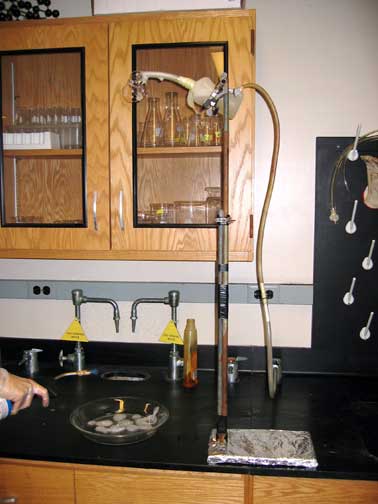Combustion of methane gas bubbles
 Methane gas is bubbled through a soap solution. The natural gas bubbles encounter an open flame, with explosive results.
Methane gas is bubbled through a soap solution. The natural gas bubbles encounter an open flame, with explosive results.
Ingredients: soap solution, methane gas, propane torch
Procedure: A minimal recipe follows.
1. Immerse a line of methane gas in a container of soap "bubble" solution.
2. Allow the bubbles to flow out of the container and into the air.
3. Ignite the bubbles with an open flame, such as a propane torch.
Understanding: The reaction of methane gas with air and an open flame is a combustion reaction
CH4(g) + 2 O2(g) → CO2(g) + 2 H2O(g)
The oxygen gas oxidizes the carbon in the hydrocarbon methane. This reaction is quite similar to the combustion of octane gasoline in a car's combustion engine.
 Consider the molecules involved in the reaction. A tetrahedral methane molecule encounters linear dioxygen molecules, reacting to form a linear carbon dioxide molecule and a bent water molecule. From the overall reaction, we see that methane combines with oxygen in a 1:2 molecular ratio. The elementary reaction may indicate a different series of steps occurring at the molecular level, leading to the atomic balance summarized in the overall reaction.
Consider the molecules involved in the reaction. A tetrahedral methane molecule encounters linear dioxygen molecules, reacting to form a linear carbon dioxide molecule and a bent water molecule. From the overall reaction, we see that methane combines with oxygen in a 1:2 molecular ratio. The elementary reaction may indicate a different series of steps occurring at the molecular level, leading to the atomic balance summarized in the overall reaction.
The bonds between hydrogen and oxygen in water are single bonds. The bonds between the oxygen atoms in dioxygen, and between the carbon and oxygen atoms in carbon dioxide, are double bonds. The single bonds are weaker than double bonds. Single bonds are also longer than double bonds. Counting bonds in the reaction, we see that four single bonds and two double bonds are traded for two double bonds and four single bonds.
This reaction is quite dramatic, and a great deal of fun! Methane gas is bubbled through the soap solution to create bubbles of hydrocarbon gas. The trick is to bring those bubbles into contact with a flame. That is not easily done with a fixed flame, such as a candle placed below the falling bubbles. Let's see why.
In the absence of a candle placed below the falling bubbles, the path of the bubble is essentially straight down, toward the center of the Earth. However, when a candle is placed at the point the bubble would fall in its absence, the bubble is pushed to the side and does not fall on the candle. Why?
The hot air rising above the candle's flame pushes the falling bubble aside! So instead of letting gravity bring the bubble to the flame, we use a portable propane torch, and bring the flame to the bubble!
A mole's work and the strength of chemical bonds
Question: We have an idea of bond strength from the structure of molecules. In general, single bonds are weaker than double bonds are weaker than triple bonds. The strongest heteronuclear diatomic bond is found in carbon monoxide. Our best Lewis structure says that there is a triple bond between the carbon and oxygen. Let's consider just how strong it is.A Power Bar has approximately 200 Calories. That is Calorie with a capital C which is actually a kilocalorie that we write kcal. (1 cal = 4.184 J.) You can use the Power Bar's calories to do useful work.
Riding a bike at a good pace might be taken as climbing 50 m every 5 minutes. If you and your bike have a combined mass of 85 kg, how much work do you do per hour? How long will the fuel provided by a Power Bar keep you riding?
To pull apart a CO molecule (into an O atom and a C atom) requires very little energy -- about 4 x 10-22 kcal. However, to pull apart a mole of CO molecules requires a great deal more work. Compare the energy spent pulling apart a mole of CO molecules to the energy expended riding your bike for one hour.
Useful information: 4.184 J = 1 calorie. To lift a mass m a height h requires work of w = m g h where g = 9.8 m/s2.
The carbon monoxide (CO) molecule vibrates at a
frequency of 64 x 1012 s-1
(that is 64 trillion vibrations per
second). The CO molecule's vibration is its
internal clock. How long will it take a CO molecule to vibrate as many
times as your heart has beat in your lifetime?
Molecular heartbeats
Question: Your heart is an internal clock.
Measure your heart rate. How many times does your heart beat
each day? How many times has your heart beat
in your lifetime?